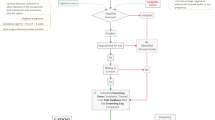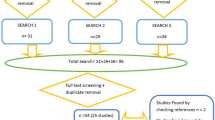Abstract
Purpose
The present meta-analysis aims to assess the efficacy of cervical cerclage retention after the occurrence of preterm premature rupture of the membranes by analyzing the observed maternal and neonatal perinatal outcomes.
Methods
We searched Medline (1966–2014), Scopus (2004–2014), Clinicaltrials.org (1997–2014), Cochrane Central Register of Controlled Trials (CENTRAL) (1999–2014) and Google Scholar (2004–2014) search engines, as well as reference lists from all included studies. The statistical analysis was performed using the RevMan software.
Results
Six studies were finally included in the present review, involving 293 parturient. Cerclage retention did not significantly prolong the gestational latency period (MD 2.56 days, 95 % CI − 1.06, 6.71). It did, however, increased the rates of delivery after the first 48 h (OR 6.27, 95 % CI 1.08, 36.24). As a technique, it did not significantly increase the rates of neonatal sepsis (OR 1.42, 95 % CI 0.65, 3.12) or the neonatal death rates (OR 1.09, 95 % CI 0.48, 2.47).Maternal chorioamnionitis was, however, significantly more prevalent among women offered cerclage retention (OR 1.78, 95 % CI 1.02, 3.12), although the same was not observed in the case of postpartum endometritis (REM OR 4.73, 95 % CI 0.74, 30.09).
Conclusions
Current evidence is insufficient to support the retention of cervical cerclage after the occurrence of PPROM, therefore, its implementation should be exceptionally instituted in everyday clinical practice, until further evidence becomes available.






Similar content being viewed by others
References
Alfirevic Z, Stampalija T, Roberts D, Jorgensen AL (2012) Cervical stitch (cerclage) for preventing preterm birth in singleton pregnancy. Cochrane Database Syst Rev 4:CD008991. doi:10.1002/14651858.CD008991.pub2
ACOG Committee on Practice Bulletins-Obstetrics (2007) ACOG Practice Bulletin No. 80: premature rupture of membranes. Clinical management guidelines for obstetrician-gynecologists. Obstet Gynecol 109(4):1007–1019. doi:10.1097/01.AOG.0000263888.69178.1f
Walsh J, Allen VM, Colford D, Allen AC (2010) Preterm prelabour rupture of membranes with cervical cerclage: a review of perinatal outcomes with cerclage retention. J Obstet Gynaecol Can 32(5):448–452
Liberati A, Altman DG, Tetzlaff J, Mulrow C, Gotzsche PC, Ioannidis JP, Clarke M, Devereaux PJ, Kleijnen J, Moher D (2009) The PRISMA statement for reporting systematic reviews and meta-analyses of studies that evaluate healthcare interventions: explanation and elaboration. BMJ 339:b2700. doi:10.1136/bmj.b2700
Hozo SP, Djulbegovic B, Hozo I (2005) Estimating the mean and variance from the median, range, and the size of a sample. BMC Med Res Methodol 5:13. doi:10.1186/1471-2288-5-13
Ludmir J, Bader T, Chen L, Lindenbaum C, Wong G (1994) Poor perinatal outcome associated with retained cerclage in patients with premature rupture of membranes. Obstet Gynecol 84(5):823–826
Jenkins TM, Berghella V, Shlossman PA, McIntyre CJ, Maas BD, Pollock MA, Wapner RJ (2000) Timing of cerclage removal after preterm premature rupture of membranes: maternal and neonatal outcomes. Am J Obstet Gynecol 183(4):847–852. doi:10.1067/mob.2000.109039
McElrath TF, Norwitz ER, Lieberman ES, Heffner LJ (2000) Management of cervical cerclage and preterm premature rupture of the membranes: should the stitch be removed? Am J Obstet Gynecol 183(4):840–846. doi:10.1067/mob.2000.108870
Kominiarek MA, Kemp A (2006) Perinatal outcome in preterm premature rupture of membranes at < or = 32 weeks with retained cerclage. J Reprod Med 51(7):533–538
Aguin E, Van De Ven C, Cordoba M, Albayrak S, Bahado-Singh R (2014) Cerclage retention versus removal following preterm premature rupture of membranes and association with amniotic fluid markers. Int J Gynaecol Obstet. doi:10.1016/j.ijgo.2013.10.005
Galyean A, Garite TJ, Maurel K, Abril D, Adair CD, Browne P, Combs CA, How H, Iriye BK, Kominiarek M, Lu G, Luthy D, Miller H, Nageotte M, Ozcan T, Porto M, Ramirez M, Sawai S, Sorokin Y, Obstetrix Perinatal Collaborative Research N (2014) Removal versus retention of cerclage in preterm premature rupture of membranes: a randomized controlled trial. Am J Obstet Gynecol 211(4):399.e1–7. doi:10.1016/j.ajog.2014.04.009
McElrath TF, Norwitz ER, Lieberman ES, Heffner LJ (2002) Perinatal outcome after preterm premature rupture of membranes with in situ cervical cerclage. Am J Obstet Gynecol 187(5):1147–1152
Dl M, Yinon Y, Whittle WL (2012) Preterm premature rupture of membranes in the presence of cerclage: is the risk for intra-uterine infection and adverse neonatal outcome increased? J Matern Fetal Neonatal Med 25(4):424–428. doi:10.3109/14767058.2011.569800
Miyazaki K, Furuhashi M, Yoshida K, Ishikawa K (2012) Aggressive intervention of previable preterm premature rupture of membranes. Acta Obstet Gynecol Scand 91(8):923–929. doi:10.1111/j.1600-0412.2012.01432.x
Wetta LA, Szychowski JM, Seals S, Mancuso MS, Biggio JR, Tita AT (2013) Risk factors for uterine atony/postpartum hemorrhage requiring treatment after vaginal delivery. Am J Obstet Gynecol 209(1):51.e1–6. doi: 10.1016/j.ajog.2013.03.011
Newman DE, Paamoni-Keren O, Press F, Wiznitzer A, Mazor M, Sheiner E (2009) Neonatal outcome in preterm deliveries between 23 and 27 weeks’ gestation with and without preterm premature rupture of membranes. Arch Gynecol Obstet 280(1):7–11. doi:10.1007/s00404-008-0836-8
Goya M, Bernabeu A, Garcia N, Plata J, Gonzalez F, Merced C, Llurba E, Suy A, Casellas M, Carreras E, Cabero L (2013) Premature rupture of membranes before 34 weeks managed expectantly: maternal and perinatal outcomes in singletons. J Matern Fetal Neonatal Med 26(3):290–293. doi:10.3109/14767058.2012.733779
Martinelli P, Sarno L, Maruotti GM, Paludetto R (2012) Chorioamnionitis and prematurity: a critical review. J Matern Fetal Neonatal Med 25(Suppl 4):29–31. doi:10.3109/14767058.2012.714981
Czikk MJ, McCarthy FP, Murphy KE (2011) Chorioamnionitis: from pathogenesis to treatment. Clin Microbiol Infect 17(9):1304–1311. doi:10.1111/j.1469-0691.2011.03574.x
Howman RA, Charles AK, Jacques A, Doherty DA, Simmer K, Strunk T, Richmond PC, Cole CH, Burgner DP (2012) Inflammatory and haematological markers in the maternal, umbilical cord and infant circulation in histological chorioamnionitis. PLoS ONE 7(12):e51836. doi:10.1371/journal.pone.0051836
Kovo M, Schreiber L, Ben-Haroush A, Shor S, Golan A, Bar J (2012) Intrapartum fever at term: clinical characteristics and placental pathology. J Matern Fetal Neonatal Med 25(8):1273–1277. doi:10.3109/14767058.2011.629248
Smulian JC, Bhandari V, Vintzileos AM, Shen-Schwarz S, Quashie C, Lai-Lin YL, Ananth CV (2003) Intrapartum fever at term: serum and histologic markers of inflammation. Am J Obstet Gynecol 188(1):269–274
Trochez-Martinez RD, Smith P, Lamont RF (2007) Use of C-reactive protein as a predictor of chorioamnionitis in preterm prelabour rupture of membranes: a systematic review. BJOG 114(7):796–801. doi:10.1111/j.1471-0528.2007.01385.x
van de Laar R, van der Ham DP, Oei SG, Willekes C, Weiner CP, Mol BW (2009) Accuracy of C-reactive protein determination in predicting chorioamnionitis and neonatal infection in pregnant women with premature rupture of membranes: a systematic review. Eur J Obstet Gynecol Reprod Biol 147(2):124–129. doi:10.1016/j.ejogrb.2009.09.017
Acknowledgments
No sources of funding.
Conflict of interest
The authors report no conflict of interest.
Author information
Authors and Affiliations
Corresponding author
Rights and permissions
About this article
Cite this article
Pergialiotis, V., Gkioka, E., Bakoyiannis, I. et al. Retention of cervical cerclage after preterm premature rupture of the membranes: a critical appraisal. Arch Gynecol Obstet 291, 745–753 (2015). https://doi.org/10.1007/s00404-014-3551-7
Received:
Accepted:
Published:
Issue Date:
DOI: https://doi.org/10.1007/s00404-014-3551-7




